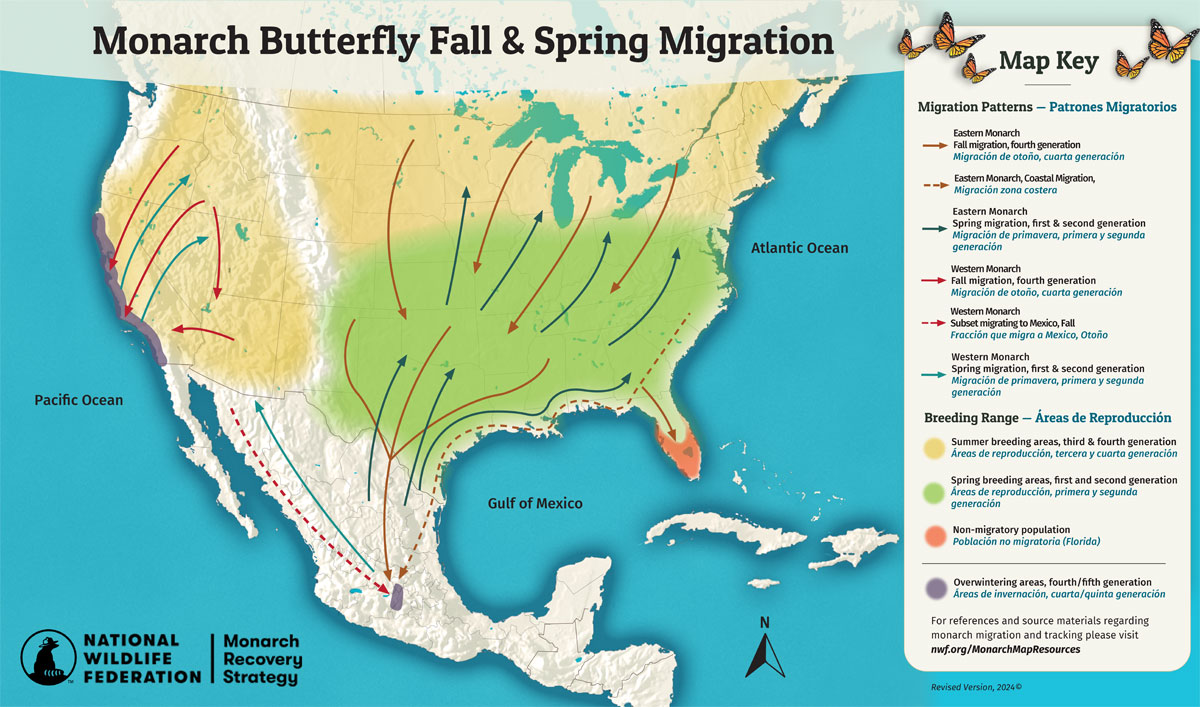How You Can Help!
Learn more about monarch migration
Take action by urging Congress to pass the Monarch Action, Recovery, and Conservation of Habitat Act
NWF’s North American monarch migration map was produced in collaboration with graphic designers, NWF monarch science experts, and other organizations’ monarch science experts. Monarch Watch provided digital Geographic and Topographic maps. We layered up-to-date scientific information on the migration of the eastern and western monarch populations. We thank and value the input from all NWF staff, Xerces Society, and Monarch Watch that has led us to produce NWF’s first monarch migration map. Context regarding our external sources will be below.
The science regarding the North American monarch migration is still developing. Therefore, our map will continue to evolve and be updated as further data regarding monarch migration and breeding areas become available.
Notes about the Eastern Monarch Migratory Pathway:
The eastern monarchs overwinter in the Monarch Butterfly Biosphere Reserve (South-Central Mexico). Eastern monarchs break diapause—their state of arrested reproduction—as spring temperatures rise. These monarchs will mate and then initiate their migration north as they lay eggs in Northern Mexico and the Southern U.S. (Texas).
The migration of the eastern monarch population has been tracked since the early seventies which makes the eastern monarch migration routes in the east more comprehensible and detailed.
Notes about the Western Monarch Migratory Pathway:
Some public data suggests that some portion of the western migratory monarch population overwinters in some areas of Arizona. As more relevant information and data regarding this overwintering population is available we will assess how to address such findings in this map.
There are also reports of the recovery or sighting of some western monarchs overwintering in the Monarch Butterfly Biosphere Reserve, which supports the fact that some western monarchs will migrate to South-Central Mexico to overwinter.
References and Source Materials:
- USDA Plants Database: Range and distribution of showy milkweed (Asclepias speciosa) west of the Rocky Mountains. Used as a reference to determine the potential range of the western monarch butterfly (based on native milkweed breeding range).
- BONAP: Range and distribution of showy milkweed (Asclepias speciosa) west of the Rocky Mountains. Used as a reference, together with the USDA Plants Database, to determine the potential range of the western monarch butterfly (based on native milkweed breeding range).
- Xerces Society: Xerces Society’s western migration monarch map was a helpful resource in determining the scientific accuracy of the western monarch migration patterns. Thanks to the Xerces Society’s up-to-date western migration map, we are using the most up-to-date data to represent the summer and spring breeding areas for the western monarch and the potential coastal migration patterns from Mexico’s overwintering areas to Arizona.
- Southwest Monarch Study-The State of Danaus plexippus in Arizona: Will provide further information on the western monarch overwintering patterns in Arizona.
- Monarch Butterfly Biosphere Reserve: UNESCO World Heritage list includes the Monarch Butterfly Biosphere.
- Monarch Watch tagging program
- Journey North spring and fall monarch sightings public reports



